A visitor ponders near Rodin’s “Thinker.”
Image courtesy of: The Architect’s Newsletter
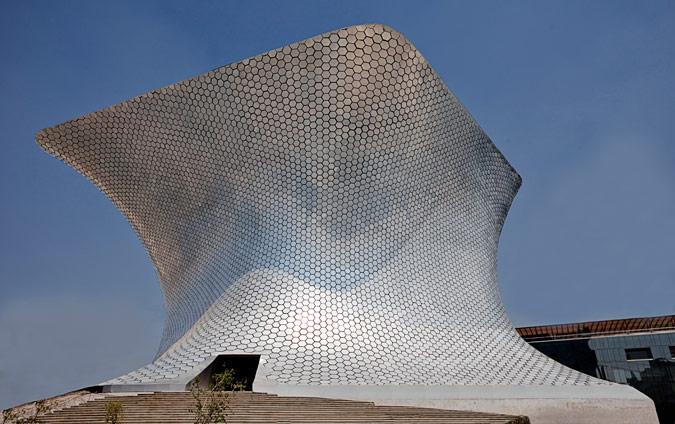
Slim believes that “All desirable things must be accessible. It’s a gift to the city.” In such, the museum entrance is free to everyone in Mexico, perhaps this is a small gesture of social responsibility.
Museo Soumaya was named for Slim’s wife, Soumaya Domit, who died in 1999.
Image courtesy of: The Architect’s Newspaper, photographed by: Adam Wiseman
Museo Soumaya is the lovechild of Carlos Slim Helu, a Mexican entrepreneur and one of the world’s richest men. Open since 2011, it houses 66,000 pieces from Slim’s extensive collection. The enormous collection includes pre-Hispanic and colonial coins, Mexican murals, modernist paintings by Picasso and Miro, and the largest collection of Rodin sculptures outside of France. Nevertheless, the museum houses predominately Central American and European art… a favorite of Slim’s.
Donated and constructed entirely by Slim, it covers 170,000-square-feet of space and stands six stories high. The shiny building in Mexico City’s exclusive Polanco district cost $70 million to build and, as Slim says, “It’s a gift to the city.”
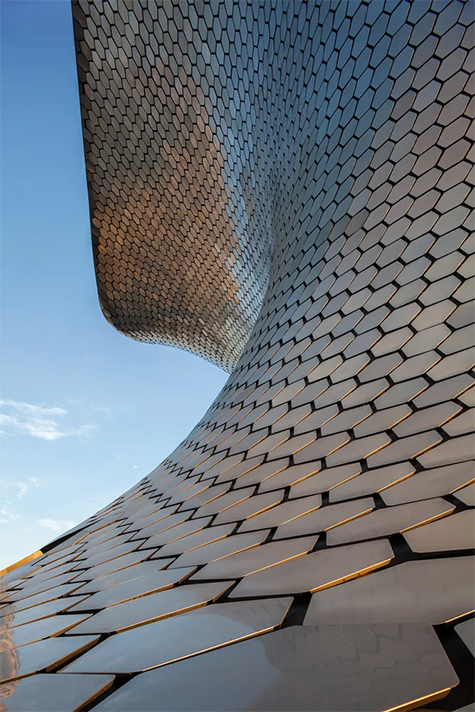
The “scales” reference the area’s traditional colonial ceramic-tiled building facades. They also give the museum a varying appearance depending on weather, time of day, and viewer vantage point… all while optimizing the preservation and durability of the building.
Image courtesy of: Divisare, photographed by: Rafael Gamo
The museum was designed by Fernando Romero Enterprise (FR-EE), one of Mexico’s most acclaimed young firms; coincidently, Romero is Slim’s son-in-law. Romero’s design references the iconic and often-criticized ramp of New York City’s Guggenheim Museum which was designed by one of the greats, Frank Lloyd Wright.
Rising up as a vortex with a “skin” made of 16,000 hexagonal tiles of mirrored steel, the building is definitely a photogenic image. The scales clad a rotated rhomboid that is supported by 28 curved steel columns of varying scale and shape. The aluminum scales (supplied by one of Slim’s companies) make the structure iconic among the architecture of Mexico city. The 150-foot-tall structure rises as the heart of the city’s new and commercial district, Plaza Carso… also planned and designed by FR-EE and owned by Slim.
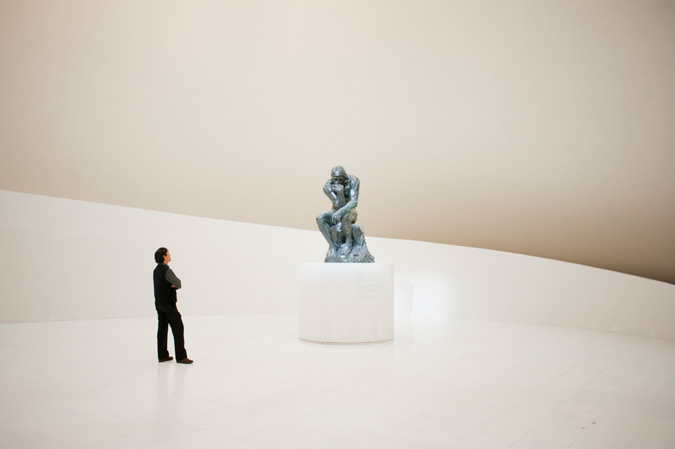
A visitor ponders near Rodin’s “Thinker.”
Image courtesy of: The Architect’s Newsletter
The design inside feels a lot like that of Frank Lloyd Wright’s Guggenheim Museum in New York City. Nevertheless, the ramp at Museo Soumaya is a lot less formal and impactful than the Guggenheim’s… and with no rotunda, the meaning gets lost. However, the large ramp up six floors centralizes the structure and is really the only way to arrive at the different levels.
The ground floor is designed mainly for public functions and opening events. The only work on display on the first floor is Rodin’s “Thinker”, which is on permanent display. The lower floors are smaller and used for temporary exhibits, while the upper levels house Slim’s personal and eclectic collection. Items in these galleries are world-class masterpieces and design objects and rare automobiles.
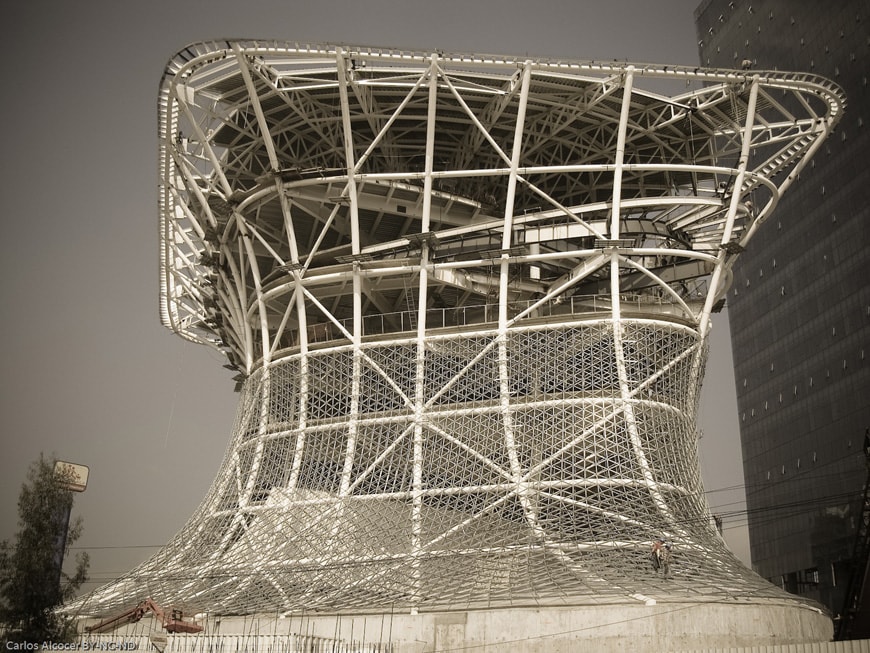
During construction…
Image courtesy of: inexhibit.com
Fernando Romero retained Gehry Technologies (founded by Frank Gehry) to coordinate the complex 3-D engineering of the building. The firm is known for its Digital Project software, “This software enables engineers to visualize all construction disciplines in one tridimensional model, preventing conflict and allowing real-time changes.”
The collaboration between Romero and Gehry was how the museum’s form- a rotated rhomboid supported by 28 curved steel columns of varying size and shapes- came about. Construction took three years, a time-frame that stayed relatively on par with the original prediction.
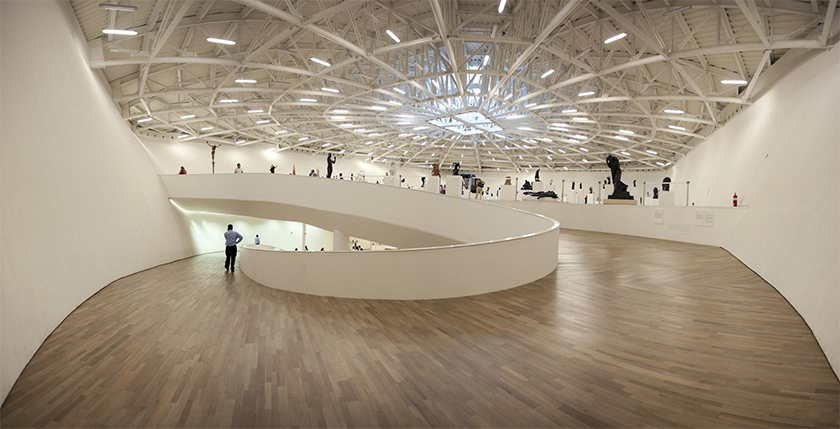
The top floor, light filled because of the cantilevering.
Image courtesy of: Arch Daily
Unique in a Latin American museum is the large collection of pieces by European artists such as El Greco, Van Gogh, Matisse, Picasso, and Degas. It is nearly impossible to see impressionist paintings in this part of the world, and the fact that there are available and free of charge to an audience in Mexico is amazing. Among the “not to miss” pieces are several of Tamayo and Riviera, both Mexican artists that local (and international) viewers adore.
Some critique the architecture and the works inside; but whatever your view, realize that this is a wonderful opportunity for local citizens to be among some of the world’s most priceless and interesting pieces… a chance that they would not have gotten had Slim not built Museo Soumaya.